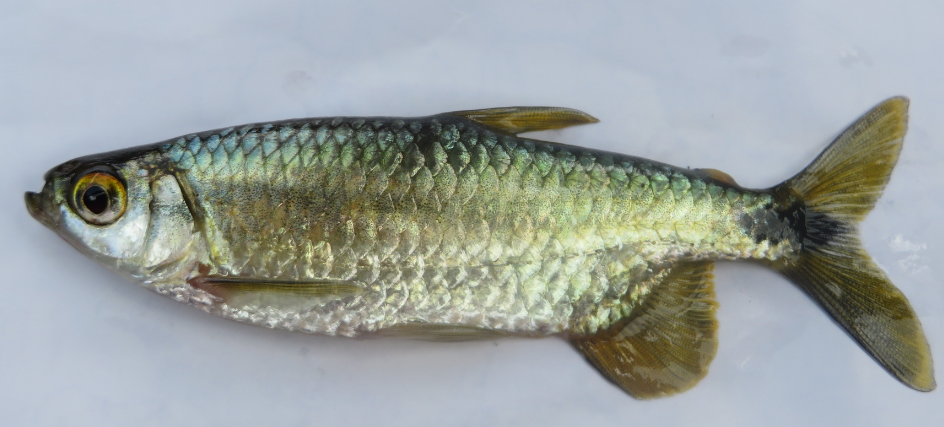Common names:
Victoria robber
Local: Nsoga
Taxonomic tree
Kingdom: Animalia
Phylum: Chordata
Class: Actinopterygii (ray-finned fish)
Order: Characiformes (Characins)
Family: Alestidae (African tetras)
Genus: Brycinus
Species: Brycinus jacksonii (Boulenger, 1912)
Number of Occurrancies: 86
Etymology (based on Scharpf & Lazara, 2019)
- Brycinus: –inus, an adjectival suffix, Brycon-like (general term for characiform fishes), derived from bryco, to bite, gnash teeth or eat greedily, originally an allusion to fully toothed maxillae.
- jacksonii: in honor of Frederick John Jackson (1859-1929), English administrator, explorer and ornithologist, who collected type
Synonyms: click here to view synonyms
Type locality: Malawa River, Kavirondo, Uganda. Holotype at British Museum of Natural History (BMNH)
Distinguishing characters for the genus
- Short snout
- Small and non-protractile mouth; teeth firmly fixed, those of the outer series stout and not compressed basally
- Two series of functional multi-cuspidate teeth in the upper jaw, the outer series usually tri-cuspid and less massive than the stout, many cusped teeth in the inner series
Distinguishing characters for the species
- Dorsal fin grey, anal and pelvic fins with a faint orange or yellow tinge; adipose fin orange; caudal yellow or orange (Diagnostic)
- Depth of the body contained up to 3-4 times in standard length, and length of the head 3.5 (in young) to 4 times
- Head 1.75 to twice as long as broad; fronto-parietal fontanelle absent
- Snout rounded, equal or slightly longer than the eye, whose diameter is contained 2.5 (in young) to 4 times (in adults) in the head length
- Adipose lids are barely visible
- Maxilla not reaching the anterior orbital margin
- 8 teeth in each of the upper jaw series, 8 and 2 in the outer and inner lower jaw series
- Gill rakers moderately long, 16-18 on the lower limb of the first gill arch
- Dorsal fin with 10 rays, the first two unbranched; its origin above the pelvic fin insertion
- Anal fin with 18 or 19 rays
- Lateral line scales 25-29, usualy 27, 4.5-5.5 between lateral line and origin of the dorsal fin
- Colour is Silver, bluish-grey to blue-black dorsally. A large black blotch on the caudal peduncal, with a narrow extension on to the caudal fin; a round black spot behind the head, often faint or invisible in life but intensified after death (Diagnostic).
Taxonomic remarks: The species is commonly reported in old literature as Alestes jacksonii, which is currently a senior synonym (Froese and Pauly, 2019). In general appearence, B. jacksonii closely resembles Brycinus sadleri and Brycinus nurse. It differs from these species principally in the number of anal fin rays (18 or 19) compared with 11-14 in B. nurse and 20-21 in B. sadleri, number of lateral line scales compare: 31-34 in B. sadleri and 30 in B. nurse), and in the coloration of the the fins (i.e. dorsal, pelvic, and anal fins tinged with vermilion and vivid red caudal lobes in B. nurse and all grey fins in B. sadleri).
Distribution in Uganda: Lake Victoria (and some affluent rivers and streams), Lake Nabugabo, Victoria Nile and Malawa river
Occurence: Native
Habitat: Pelagic; common in shallow waters forming shoals.
Feeding: Omnivorous, feeding on insects, especially chironomid pupae, with small fishes (haplochromines and Silver cyprinids) less frequent, plants and snails.
Biology: Adults range between 15-23 cm long, occasionally as large as 27 cm. In Lake Victoria, the species is known to run up the rivers and streams during rainy seasons to spawn.
Economic importance/End use: The species is not common in catches especially since Nile perch upsurge
IUCN conservation status: click here to view IUCN status
Threats: Predation by Nile perch
Main references
- Greenwood PH. 1966. The fishes of Uganda. The Uganda Society, Kampala. 131 pages.
- Sharpf C, Lazara J.K. 2019. Fish Name Etymology Database v17. www.etyfish.org
- Froese R., Pauly, D. 2019. FishBase. World Wide Web electronic publication. www.fishbase.org, version (12/2019).


